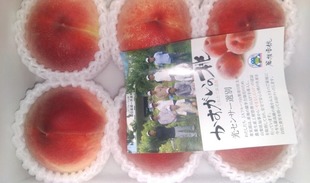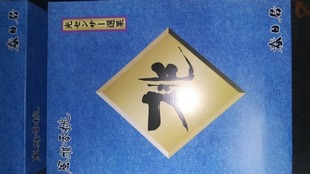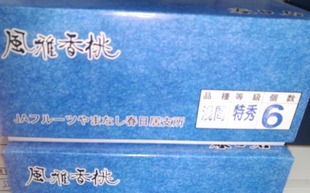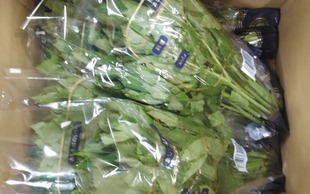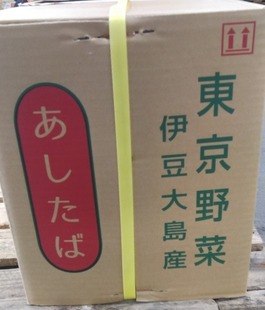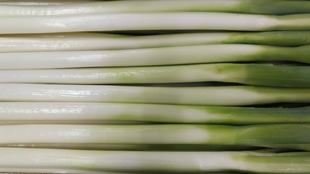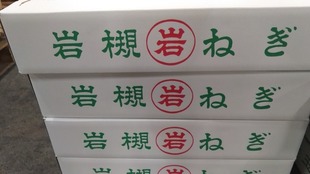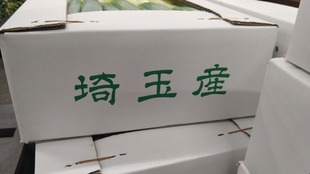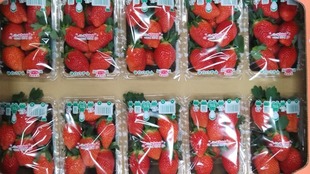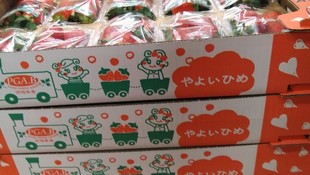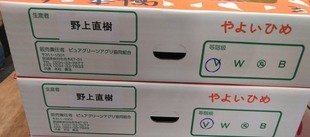Science of the Living Body, Vol. 70, No. 5 (starting with the October 2019 issue) Dr. Tomio TADA (1934-2010) was the first in the world to use an experimental system for IgE antibody production to announce the existence of suppressor T cells that respond to helper T cells and control antibody production by B cells. He was a rare man who possessed both scientific talent and literary ability. He is known, in a good way, as a mysterious eccentric. In 1966, Ishizaka Kiminari and Teruko, a married couple at the Pediatric Asthma Research Institute in Denver, Colorado, USA: IgE antibodies
【Product name】
Yellow-core cabbage(Mother nature’s Gift)
【Type】
Brassica rapa var. pekinensis
【Production area】
Oaza-Higashimoro, Yuki City, Ibaraki Prefecture (Inaba horticulture Co., Ltd.)
【Origin of the name】
Isn’t it named for its low-temperature heading properties, few physiological disorders, and the gorgeousness of place names and products?
【Main features】
In YUKI City, Ibaraki Prefecture, about 400 households grow Chinese cabbage, and it is the production area with the largest number of producers in the prefecture, which boasts the largest planted area and yield in Japan. The city’s specialty, “NAOMI cabbage,” is characterized by its soft texture and sweet taste, and normally, full-scale shipment will begin in mid-November. Appearance of Oshin Chinese cabbage: It is the same as ordinary Chinese cabbage, but the leaves are yellower toward the inside. The leaves tend to be soft, freshly picked and fresh and sweet. Chinese Cabbage -The arrival to Japan was unexpectedly late, around the beginning of the Meiji era. Even at that time, it was difficult to collect seeds and it was not widely used. The Japanese army at that time brought back the seeds that had largely headed in the former Manchuria and Korea to Japan: In the Sino-Japanese War and the Russo-Japanese War. Agricultural workers repeated trial production, which was the reason for the spread nationwide. It was good to be able to talk about the efforts and respect of our predecessors. At the time of the 1980s, it seems that yellow-core varieties were also varieties that were prone to physiological disorders and difficult to cultivate. Meanwhile, the variety that was born in 1996 is “F1 Yellow Sesame” (currently: Yellow Sesame 85, Takii Seed Co., Ltd.), which is a yellow core type and has both quality and cultivation stability. Seeds, lime deficiency and sesame disease (It is said to be a physiological disorder of Brassica rapa subsp. pekinensis. Hakusai: Chinese cabbage cells react to stress during cultivation, and discoloration of the cell wall due to accumulation of polyphenols appears as black spots. Physiological disorder So eating does not seem to have any effect on the human body. The main causes are excess N, high and low temperatures, delayed harvest time, dense planting, and heavy use of bactericides containing copper, but it is clear. It seems that the clarification has not been made. Also, it seems that the symptoms may increase by long-term storage at low temperature after harvesting. Furthermore, it seems that there is a big difference in the occurrence of sesame disease depending on the variety. It seems that N fertilizer does not work too much and early harvest is good.) Also, it is important to select strong varieties and widen the space between the plants. Easy year-to-winter, with excellent low-temperature hypertrophy and wide seeding period. Due to excellent low-temperature hypertrophy and cold resistance, it is sown from late August to early September in the middle region and until mid-September in the warm region. It seems that the seeding period is wide. It is a labor-saving variety with excellent workability and yield, and the outer leaves are strong and extremely upright, so topdressing, chemical spraying, and bundling work are easy. The sesame seeds are outstanding and the rate of excellence is high. The color of the bulb is bright yellow, the leaves are soft, the sweetness and taste are excellent, and the quality is good. The appearance of Chinese cabbage is the same as that of general Chinese cabbage, but the leaves become yellower toward the inside. The leaves are soft, freshly picked and fresh and sweet. The color is beautiful, so you can eat pickles, stir-fried foods, and even raw, so it’s delicious as a salad. The most recommended is food cooked in a pot, which becomes a pot with a beautiful yellow color and a beautiful color when heated. It is fun to use as an ingredient for sukiyaki, cream boiled, and miso soup. Around mid-February 2022, a new disaster prevention nuclear shelter was added to the Hometown Tax Donation Program in return. It is a product developed by a company in the city for general households, equipped with a special filter that removes radioactive substances, etc., and it seems that it can be installed if there is space for one passenger car. The manufacturer’s selling price is about 5.7 million yen. The amount of donations in 2021 seems to have reached the highest monthly amount of 20.9 million yen in the city. According to the city, the municipality that set up a shelter for gifts is the second largest after Yaita City, Tochigi Prefecture. Sheet metal processing company Direct Engineering Co., Ltd. (Headquarters: Tama, Yuki City, since its establishment in 1979, has been involved in various welded sheet metal processing, laser processing, mold processing, blank processing for over 30 years. The company is an emergency private power generation package. In charge of the sheet metal department of the company, managed by an integrated system from ordering to shipping) was launched in December 2021. It is made of steel and can accommodate up to 5 people. It is 2 meters wide, 4 meters deep and 2 meters high. It weighs about 2.3 tons. The international standard Israeli special air filtration filter, which has a lead plate on the back of the ceiling and walls to remove radioactive substances and toxic gases, is CBRN compatible (chemical, biological, radiological). The CBRN protection system is certified by the “NATO army” and is widely adopted by the armed forces of each country in NATO, as well as the armed forces of the United States and Germany. It is also widely used not only by the military but also by police and firefighting organizations. In Japan, the CBRN protection system is used for special fire engines, and it is a device that can operate stably in an emergency with high performance. Approximately 99.995% of toxic substances (radioactive substances, VX gas, sarin, etc.) are blocked, so you can evacuate with peace of mind), as well as air conditioners, light emitting diode (LED) lighting, external power outlets, etc. In addition, the company, which was considering sales channels and PR methods, consulted with the city and decided to participate in the hometown tax payment, which is attracting a lot of attention nationwide. You can apply on the site, but the delivery area seems to be only in the Kanto region excluding remote islands. The city’s hometown tax payment began in 2008, and the donation amount in 2020 was 167,460,000 yen. It seems that it is expected to exceed 200 million yen this year. Currently, there are about 244 reward items including shelters, and the main items are Yuki tsumugi ties, beef, rice, vegetables, miso, sake and other foods, as well as child seats and drive recorders from manufacturers operating in the city. It seems certain. “Yuki City, Ibaraki Prefecture” : One of the few cities that leaves a medieval castle town in the northern part of the city. A new urban area is formed in the south, and further south is the Agriculture area. The terrain is generally flat and covered by the loamy layer of the Kanto Region. Yuki Plateau: A tributary of the Tone River; Sandwiched between the rivers of kinugawa / tagawa and Nishinire River-One of the Josou Plateau. A relatively high, gentle low-ridge slope with an altitude of 20 to 45 m above sea level. City flowers: lilies: It is a pure Japanese flower that is easy to get close to, easy to cultivate, and does not take up much space. In addition, it is suitable for general households, and you can enjoy the fragrance when the flowers are in full bloom. Its neatness brings out a unique atmosphere in “Tsumugi(Pongee)no Village” Yuki City. Flower appearance’s unassumingly attitude was chosen to symbolize City. There are many types, but no particular type has been decided-Established on November 10, 1980. City Tree: Mulberry: There is a connection to tradition. Yuki-Tsumugi / Sericulturist: Mulberries, which are closely related, have been planted in the city for a long time: Both were chosen in the hope of growth. Mulberries are brilliant when the spring sprouts sprout. It shows beauty and is generally familiar and prized as a famous tree. It’s the beauty of fresh green that you can see. Mr. Buson Yosa(1716-1786): After his teacher’s death in 1742, he went to live with Gantou ISAOKA in Yuki, the kingdom of Shimousa (Yuki City, Ibaraki Prefecture) at the age of 27. He admired Mr. Basho MATSUO so much that he followed in his footsteps on a trip to the Tohoku region. It can be seen from the ruins and burial mounds that remain in various parts of the city that the ancient Yuki region was economically open with good water transportation. After the Taika Reform, Yuki District was established as part of the country of Shimousa. In the first half of the 8th century, the abandoned temple of Yuki and the county were built. In 935, the Taira no Masakado-Ko turbulence broke out. The Yuki region also became a battlefield, and the legend of Masakado was left here. The history of Yuki, a castle town, begins with the advent of Tomomitsu YUKI-Ko. After supporting the establishment of the Kamakura Shogunate by serving by Yoritomo-Ko, Tomomitsu-Ko built a pavilion in Yuki and became the first head of the family, and after that, he became the first head of the family, and the rule of the Yuki family for about 400 years was solidified. In 1214, Shinran saint, the founder of the Jodo Shinshu sect, came to Hitachi Province. Tomomitsu-Ko is said to have opened the Shomyoji Temple by inviting Shinran’s high-ranking younger brother, Shinbutsu(Senshuji Temple II, Bukkoji Temple II)-Ko. Since Tomomitsu-Ko, the Yuki family has protected and nurtured the tsumugi industry for generations, and Yuki tsumugi has been counted as one of the national specialties. During the Muromachi period, Mr. Yuki was defeated and cut off in the Yuki battle caused by the 11th dynasty. However, it was revived during the Warring States period, and overcame many battles to further develop the castle town of Yuki. However, when Ieyasu Tokugawa took over the world, Hideyasu-Ko 18th (The first feudal lord of the Kitanosho feudal clan in Echizen Province and the first originator of the Echizen Matsudaira family.) Was ordered to be transferred to Echizen, and the rule of Mr. Yuki came to an end. The Mizuno family (Yuki Mizuno family and Yamakawa Mizuno family), who are closely related to the Tokugawa family, ruled this area during the Edo period. Tadamoto MIZUNO-Ko ruled the land of Yamakawa from 1615 to 1635. In 1700, Katsunaga Mizuno-Ko entered the prefecture from Noto. Three years later, Yuki Castle was allowed to be rebuilt, and Yuki was revived as a castle town. Yuki is located at the key point of the Kinugawa River, which is the main artery of the Edo economy, and has become extremely prosperous as a distribution center for Yuki tsumugi and agricultural products. Around this time, Mr. Buson YOSA, who is famous as a poet and painter in the Edo period, moved to the poet Mr. Ganto ISAOKA in 1742 and stayed in Yuki for about 10 years. He toured with a nearby haiku poet and left behind many haiku poems about Yuki. In addition, Mr. Buson moved to Shojuin Gugyoji Temple (Jodo sect; A temple that is one of the 18 Kanto forests. Hideyasu-Ko, the 18th generation of the Yuki family, invited Zonpa(At the age of nine, he entered the Honorary Teiha’s room and practiced, and after studying in Nanto and Kyoto, he founded Enten Temple in Kanpu Village, Inba District, Shimousa Province (Sakura City, Chiba Prefecture). In the first year of the Tensho era (1573), he became Gugyoji Temple IX, but he was burned by the battle between Ujinao HOJO-Ko and Shigetsune TAGAYA-Ko and escaped to his younger wife. When Hideyasu Yuki’s breathing daughter Matsuhime (Matsujuin) died on January 9, 1594, he served as a mentor, donated fifty stones of the temple territory, and rebuilt Kokyoji Temple in Yuki.)’s superior to the early life of Matsuhime (daughter) and built it.) and left behind fusuma paintings such as sumi plum, cherry blossom, and landscape. In the Meiji era, Yuki began to walk as a sericulture village and a town of pongee. In 1954, one town and four villages merged to form Yuki City. At that time, industries such as pongee, paulownia products, kanpyo, and leather shoes were thriving, and wholesalers lined up in the city. Yuki Tsumugi was registered as a UNESCO Intangible Cultural Heritage in 2010, and the name of Yuki City is spreading both at home and abroad. The city, which still retains its original form as a medieval castle town, is steadily developing while preserving its rich history and cultural heritage. The 14th KAZUE SHINKAWA Award (sponsored by the city, etc.), a poetry competition for elementary, junior high and high school students, was announced and the award ceremony was held on February 13, 2022 at the Citizen’s Information Center in Kokubu Town. Ms. Kazue SHINKAWA (born in Yuki, Ibaraki Prefecture in 1929. Studied under Mr. Yaso SAIJO (a representative poet of the Taisho era along with Hakushu Kitahara) from 1983 to 1993. Supporting the activities of female poets and artists widely until the end of the publication in 1993, Vol. 40), and presiding over “Modern Poetry La Mer(Mrs. Sachiko YOSHIHARA, who summarized and wrote it together, was diagnosed with Parkinson’s syndrome in 1994. In 1995, she published her final poetry collection, Luminous, compiled by Kazue Shinkawa, and in the same year she received the 3rd Hagiwara Sakutaro Award.)” magazine, supporting the activities of female poets. Others (Saisei MUROU (lyric poems such as love poetry collections and lyrical small songs collections led the poetry of the Taisho era and also played an active part as a novelist) Poet Award),“ ひきわり麦抄(花神社, 1986)” (Contemporary Poet Award), “Hatahata and page turning …” (Fujimura Memorial History Award (Shimazaki Fujimura’s birthplace, Literature Museum at the southern end of Shinshu Kisoya)), “Remembering Water” (Modern Poetry Hanatsubaki Award, Kaoru Maruyama (with the end of the war in between) From 1944 to 1948, it was estranged in Iwanesawa, Nishikawa Town, Nishimurayama District, Yamagata Prefecture, where the poet of the four seasons who served as a substitute teacher for Iwanesawa National School) Award), etc. In response, he was appointed as the Honorary Director of the Yuuki Library, which opened in May 2004.) In the 6th grade of Yuki Nishi Elementary School, Tosaka’s “Grandma’s Garden” was shining. The winners, who were commended by Mayor Kobayashi, read aloud their work and seemed to receive applause from the venue. It was founded in 2008 under the name of Ms. Kazue SHINKAWA, a poet from the city and an honorary citizen, in an attempt to foster the sensibility of young people through her poetry creation activities. Mr. Kazuyuki TAKESHI (Ibaraki Prefectural Poet Association, Japan Contemporary Poet Association member. 2015 Japan Poet Club President. Kazue from 2018 SHINKAWA Award Selection Committee Chairman. In 2021, he won the Japan Poet Club Award for “Moirai’s Eyes”). There were 1989 entries, and it seems that 1 point for the highest award, 12 points for the award for excellence, and 31 points for the award for excellence were selected. Climbing’s work spelled out that she found small lives such as insects and plants in the garden of her late grandmother’s house and felt her grandmother’s smile. Mr. Takeshi, who was selected, said, “It is wonderful to feel that many creatures are still living like reincarnations even if someone close to them dies. The composition and the carrying of words are also excellent.” The award-winning works are exhibited at the Citizen’s Information Center and are also introduced on the Yuki Library website, which has a collection of about 10,000 items such as Ms. SHINKAWA’s collection. I would like to visit in the near future and enjoy all creation.
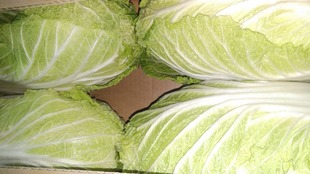
Yuki City, located in the northwestern part of Ibaraki Prefecture, is Japan’s oldest silk fabric registered as an intangible cultural heritage of UNESCO. Weaving the parts with cotton thread: Weaving with a ground machine. The most distinctive feature is the thread that is hand-picked from cotton. The silkworm cocoon is boiled, softened and spread, and is soft and contains a lot of air. It is a warm, very comfortable and gentle material. By picking up the thread by hand, it seems that the highest quality thread can be produced without spoiling the goodness of the material. Among the many tsumugi in Japan, both warp and weft It seems that only the authentic Yuki Tsumugi uses hand-tsumugi thread. This is the reason why it is considered to be the highest quality silk fabric. It has been delivered as a gift since the Nara era, but it seems that it has gained popularity in the market since the Edo era. Encyclopedia “Wakansansai COLLECTION of PICTURES: Mid-Edo, Osaka doctor RYOAN Terashima (anrindo) is the first verbal translation of Japan’s encyclopedia with figures, compiled after Ohki’s “Sansai COLLECTION of pictures” in Ming, China. From astronomical and geography to flora and fauna, personnel, etc. Introduced as the finest tsumugi.
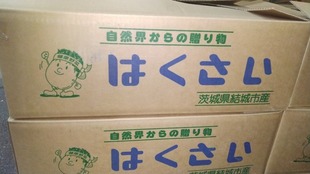
In recent years, efforts to export Chinese cabbage, a typical agricultural product, to Asia have begun. With the improvement of quality control technology and the support of the prefecture, farmers in Yuki City are embarking on exports to Singapore and Hong Kong. At agricultural sites suffering from the effects of corona and climate change, we are developing overseas sales channels that utilize online even in fruit-producing areas to survive headwinds. In Yuki City, which is the main production area of Chinese cabbage next to YACHIYO Town in the prefecture, farmers are collaborating and finding a new way of life.
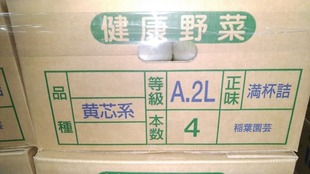
It is said that Chinese cabbage, which is an excellent ingredient, came to Japan around 1875. Even at that time, it was difficult to collect seeds and it seems that it was not widely used. After that, during the Sino-Japanese War and the Russo-Japanese War, Japanese soldiers at that time brought back delicious Chinese cabbage seeds, which had been heavily headed in the former Manchuria and Korea, to Japan and repeated trial production, which seems to have been the reason for the spread nationwide. It has been a major vegetable since before World War II, but it seems that the acreage has been declining in recent years due to the decrease in opportunities to pickle Chinese cabbage at home and the influence of westernized eating habits. It seems that Chinese cabbage in neighboring China is roughly divided into Shandong type, North China type, and South China type, but due to the relationship between climate and climate, only Shandong type is established in Japan. There are heading type, semi-heading type, and non-heading type. Most of the heads currently in circulation in Japan are head type.
